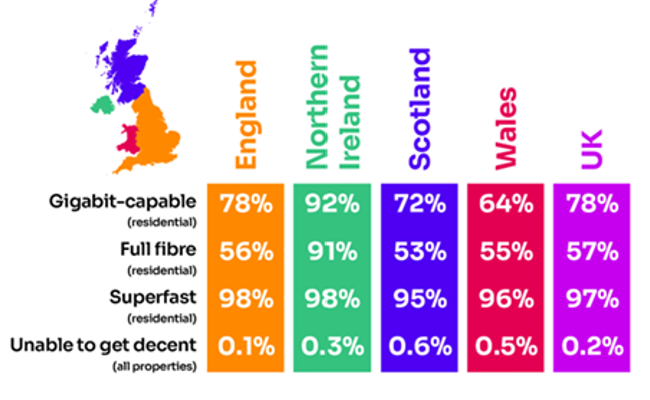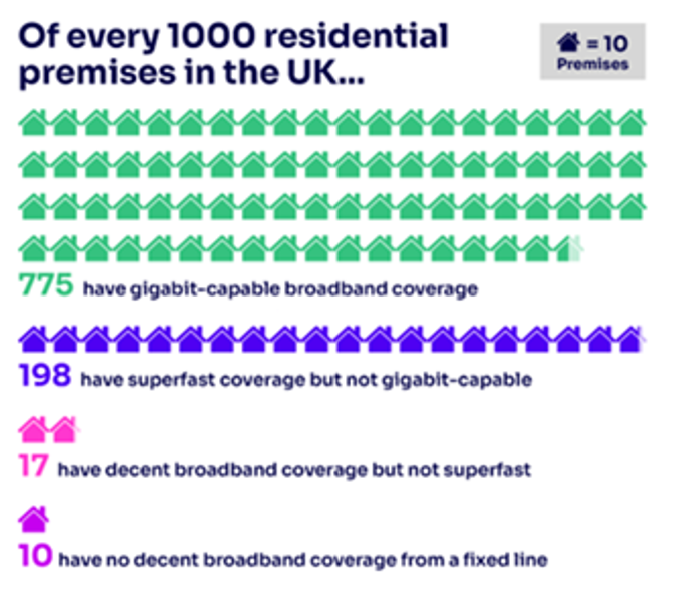
- 57% of UK homes now have access to full-fibre, up from 42% last year
- 5G mobile coverage continues to grow rapidly
A record 17 million UK homes have access to full-fibre broadband, with 4.6 million now taking it up, according to Ofcom’s latest Connected Nations report published today.
Full-fibre broadband uses fibre all the way to your home. It is more reliable and resilient than copper, and our new analysis shows that some providers experience fewer faults [1] on their fibre network compared with a copper-based network. Gigabit capable networks, which include both full fibre and cable, also deliver faster upload and download speeds that make for a better experience when gaming, working and video calling.
For the first time, full-fibre broadband is available to over half of homes in all four of the UK nations. Northern Ireland leads the way, with over nine in 10 homes (91%) able to get full fibre.

Overall, 28% of homes and businesses that can access full-fibre have taken it up, with 4.6 million premises now connected. Take-up in rural areas is nearly double that of urban homes (49% vs. 25%).
The rapid rise in availability of full-fibre broadband is good news for people and businesses across the UK, with millions more able to benefit from fast, reliable and future-proof internet.
When the time comes to take out a new broadband contract, we encourage people to shop around and find out what options are available to make sure they are on the best package for their needs.
Lindsey Fussell, Ofcom’s Network and Communications Group Director
There’s been a further reduction in the number of homes and businesses unable to access ‘decent’ [2] broadband in the last year, decreasing by over a quarter (27%) to 61,000 premises. We estimate that around 11,000 of these will be connected via publicly funded schemes by next year, showing more progress to come as the nation becomes increasingly connected.
Additionally, more homes are taking up satellite broadband, with around 42,000 UK customers connected to Starlink’s satellite service (up from 13,000 last year) – the majority in rural areas.

Rollout of 5G mobile gathers pace, as legacy networks begin to close down
The availability of 5G continues to grow rapidly, with estimated coverage provided outside of UK premises by at least one operator of over 85% [3] – a rise on last year’s 67%. 5G traffic has shown around 140% growth, representing around 17% of total mobile traffic.
The majority of mobile traffic continues to be carried over 4G, accounting for over four fifths (81%) of total data traffic. Widely accessible across the UK, 4G coverage is available from all operators outside more than 98% of UK premises.
Mobile network operators are starting to switch off their 3G networks, with EE, Vodafone and Three planning on doing so next year followed by Virgin Media O2 in 2025. Ofcom data shows that there are around 2.4 million devices still reliant on 2G or 3G networks, which has more than halved from last year’s estimated 5.5 million. Of all network data traffic, just 3% is used by 3G, which has decreased by over two fifths (44%) year on year.
Ofcom continues its work to ensure consumers are treated fairly and that disruption is minimised during the 3G switch-off process. Mobile users who are still dependent on 3G can read Ofcom’s guide.
Notes:
- Over the last three years, for both KCOM and Openreach, the fault rate (per 1,000 connections) on KCOM‘s copper access network (ADSL) and Openreach‘s copper access networks (ADSL / VDSL) was around 50% higher than the fault rates on their respective FTTP networks.
- ‘Decent’ broadband is defined by the Government as delivering at least 10 Mbit/s download and 1 Mbit/s upload speeds.
- Refers to very high confidence which is associated with around 95% probability of 5G coverage availability for areas outside of premises where at least one mobile network operator provides coverage.
